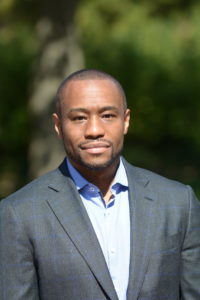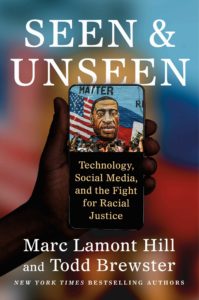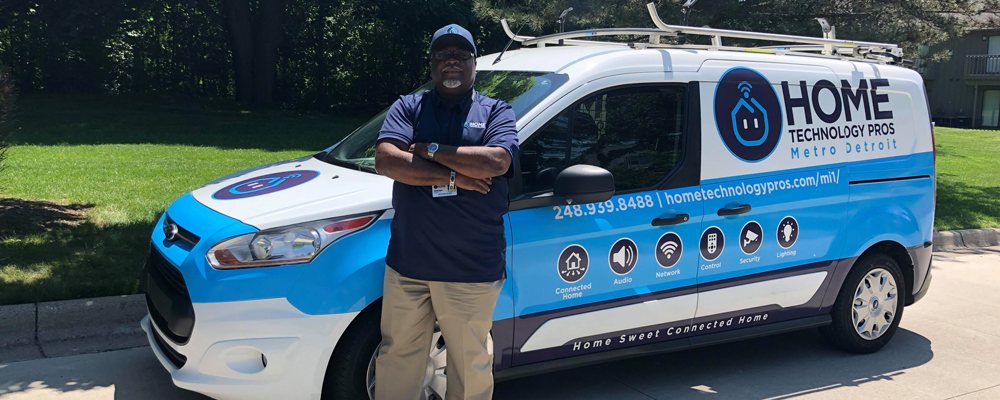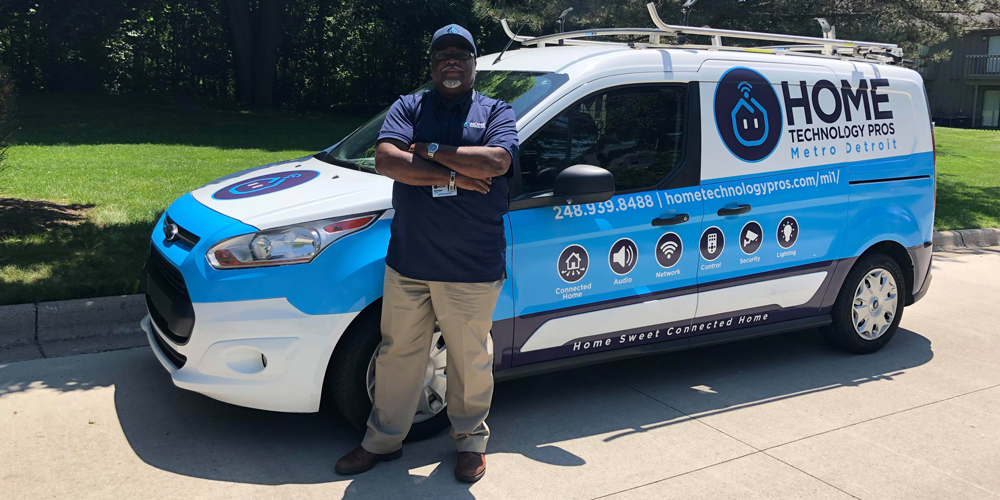
by Maina Mwaura, Urban Faith Contributing Writer | Jul 13, 2022 | Commentary, Headline News, Social Justice |
The unjust killings of African Americans at the hands of law enforcement over the past several years have become all too common news. But New York Times bestselling author Marc Lamont Hill and his co-author Todd Brewster masterfully weave together the strands of social justice uprisings, technology, and social media to talk about how the deaths of black people by police led to viral and physical social justice movements that have reshaped our national discourse.
UrbanFaith contributor Maina Mwaura spent a few moments with Marc Lamont Hill to discuss his the new book Seen & Unseen: Technology, Social Media & the Fight For Racial Justice. The full interview is above. More about the book is below.
 With his signature “clear and courageous” (Cornel West) voice Marc Lamont Hill and New York Times bestselling author Todd Brewster weave four recent pivotal moments in America’s racial divide into their disturbing historical context—starting with the killing of George Floyd—Seen and Unseen reveals the connections between our current news headlines and social media feeds and the country’s long struggle against racism.
With his signature “clear and courageous” (Cornel West) voice Marc Lamont Hill and New York Times bestselling author Todd Brewster weave four recent pivotal moments in America’s racial divide into their disturbing historical context—starting with the killing of George Floyd—Seen and Unseen reveals the connections between our current news headlines and social media feeds and the country’s long struggle against racism.
For most of American history, our media has reinforced and promoted racism. But with the immediacy of modern technology—the ubiquity of smartphones, social media, and the internet—that long history is now in flux. From the teenager who caught George Floyd’s killing on camera to the citizens who held prosecutors accountable for properly investigating the killing of Ahmaud Arbery, ordinary people are now able to reveal injustice in a more immediate way. As broad movements to overhaul policing, housing, and schooling gain new vitality, Seen and Unseen demonstrates that change starts with the raw evidence of those recording history on the front lines.
In the vein of The New Jim Crow and Caste, Seen and Unseen incisively explores what connects our moment to the history of race in America but also what makes today different from the civil rights movements of the past and what it will ultimately take to push social justice forward.


by Heidi A. Campbell, Texas A&M University | Feb 27, 2020 | Headline News |

The season of Lent is upon us. This is a holy season for Christians who seek to identify with Jesus Christ’s 40 days of fasting as he prepared to be tested and later crucified. In order to identify with Christ’s self-sacrifice, Christians often join in a symbolic fast, giving up certain foods such as meat or chocolate or even giving up certain practices.
In recent years, fasting from the internet or other forms of technology has become popular. Fasting from technology is encouraged by many religious leaders as the ideal way for individuals to reflect on their daily dependency on technology. Sometimes called taking a “digital Sabbath,” it refers to the Christian and Jewish practice, in which one day a week is set aside as sacred.
On such a day, secular practices such as using media are halted in order to help believers focus on God and their faith. This is based on the premise that the best way to critically engage with technology is to unplug from it. It’s a way to remember that true communication is unmediated by technology and grounded in being with one another in the “real world.”
Unplugging from social media or limiting one’s internet use for a set period such as during Lent can be helpful for some individuals. My research, conducted over two decades, however, shows that some of core assumptions on which digital fasting is based on can be problematic or misguided.
Technology can, in fact, be good for religion. The question is, how do we engage with technology thoughtfully and actively?
Media and immoral values?
First, let’s look at how religious groups interact and make decisions about new forms of media.
In my recent book, “Networked Theology,” my coauthor Stephen Garner and I discuss how some religious communities believe the media primarily promote immoral values and frivolous entertainment. Therefore, they insist interaction with media via digital devices should be controlled, just as is done during a digital fast.
In “Networked Theology,” we explain how abstaining from media is based on an assumption often referred to as “technological determinism.” It is a theory that argues media technology shapes how individuals in society think and act. Technology is presented as the central factor driving society, and its character is often described as selfish and dehumanizing.
This view presents the internet as a medium that creates environments that disconnect us from reality. For example, YouTube could be seen to promote entertainment culture over wisdom, Facebook encourages self-promotion over community-building and Twitter facilitates tweeting whatever comes to one’s mind rather than listening.
People are not passive users
The truth is digital media is increasingly a part of daily routines. People learn, do business and communicate with technology. Often technology enhances our daily lives, such as eyeglasses correcting vision or the telephone helping people communicate across time and space.
The problem, however, comes when we assume that people have only two options: to engage technology and inevitably be seduced by it, or refuse to use it in order to resist its power.
Digital fasting follows this second option. It presents individuals as slaves of technology. Taking the occasional timeout from the all-powerful grip of technology is done in order to simply regroup and prepare to again face its irresistible seduction.
In my view, such an approach places too much emphasis on the assertion that technological devices now dictate most people’s lives. It also does not take into account that technology users have the ability to make their own choices about how they approach it. So people can choose to use technology in ways that fulfill spiritual goals.
In “Networked Theology,” we argue that digital technology can be reshaped by users. As others have written, we agree that people should take more responsibility for the time spent with their devices.
Deepening devotion with technology
So, instead of resisting technology during Lent, individuals could use this space of holy reflection to actively consider how to integrate technology to support their spiritual development.
Religious groups have the ability to determine the culture technology promotes, if only they take time to prayerfully create their own “theology of technology.”
I describe part of this process as being “techno-selective.” What this means is reflecting on the technology we select and how and why we use it. It also means being proactive in shaping our technologies so they enhance and not distract from our spiritual journeys.
A digital Lent can become about considering how our devices can help us do justice, practice kindness and demonstrate humility in our world. For example, people could ask if their postings on Facebook are helping in creating a positive or more abusive world? Or, whether the apps they use or their cellphone etiquette promotes peace and social change?
Apps for social justice
In the last five years I have been working with a team of students at Texas A&M University to explore how social and mobile media are being developed that can support a variety of religious beliefs and practices. We found there are religious apps to help people do that. Internet memes also provide unique insights into common stereotypes about religion within popular culture.
Memes can be crafted to counter such misconceptions. For example, the wearing of hijabs, or headscarves, by Muslim women is viewed by many outside the religion as oppressive, but wearing the veil and modesty are themes frequently affirmed in memes created by Muslims.
Further, our research on religious mobile apps has found increasing numbers of apps are available that help individuals stay faithful in their religious practices on a daily basis. Apps can help with the reading of sacred texts, provide religious study aids, help locate kosher or halal products to maintain a holy lifestyle and connect people with places of worship and also to other beliefs.
Prayer and meditation apps can help users remember when to pray and become more accountable in these daily spiritual practices.
Also apps designed to encourage involvement in social justice causes, such as TraffickStop, Lose Weight or Donate and CharityMiles, help raise awareness of key issues and even help users link their daily practices, such as what they eat, to micro-donations to social justice organizations.
A digital Lent?
Lent is a great time for religious individuals and groups to pause and consider not only their own technological practices and how they shape our world but also the ways in which digital resources can be integrated into their communities to support their beliefs.
So instead of giving up Facebook for Lent, consider doing Lent digitally.
Practicing 40 days of technoselectivity might actually have a longer-term impact socially and spiritually on one’s daily life. It could even deepen religious devotion.
Heidi A. Campbell, Associate Professor, Texas A&M University
This article is republished from The Conversation under a Creative Commons license. Read the original article.

by Shari Noland | Sep 29, 2019 | Faith & Work |

Derrick Davis in front of his Home Technology Pros of Metro Detroit business truck.
When Derrick Davis launched his television career as a video engineer 35 years ago, it wasn’t uncommon for him to be the only brother on the production truck crew. Things haven’t changed much as he travels to various venues all around the country at 57, still in the field covering network sports as a broadcast maintenance engineer for WXYZ-TV in Detroit, an ABC-TV affiliate. Davis wants to change that. He promised his late father he would.
“You know what, you’ve got to stop complaining and do something about it. God Blessed you with a gift. Now that you know what that gift is and your purpose, why don’t you start training young people to do what you do?'” Davis recalls his dad Maurice telling him.
Davis pondered the idea for decades, strategizing with this dad over the years on how to make that kernel of insight into a feasible concept. He had a lot of ups and downs, setbacks and heartbreaks before soaking his 401K and feverishly saving for five years. In 2019, he launched a technology school, The AV Technology Institute, and a companion franchise business, Home Technology Pros of Metro Detroit. The goal of the Detroit-based school is to help young people who aren’t college-bound and are struggling with what they want to do in life. Many of Davis’ potential students will soon be entering the workforce out of high school or possibly coming out of the prison system. The franchise, which helps people install home theater systems, home networking and more, will give those who finish his program the opportunity to gain hands-on experience as interns. Unfortunately, his dad died before he could see the vision become a reality.
“Literally three days before he passed, we were sitting at the kitchen table, and out of the blue he said, ‘Did you start that school yet?’ and I said, ‘no,'” Davis recalls.
His dad responded, “What are you waiting for?”
Davis answered him, “I don’t know.” That conversation, so close to his dad’s death, haunted Davis and spurred him into action. “From that point on, I made it my sole mission to make sure that I got this tech school off the ground to give back to the community. I have funded everything I’ve done thus far. It’s all or nothing, and I believe it’s for the glory of God to do what He promised me, that vision that He set in me.”
The idea of being an educator was a hard one to adjust to, even though his dad, a pastor, and former middle school band director, had told him previously that it was in his DNA. Davis’ mom, who also has passed away, was a second-grade teacher. Several people in his family are educators, principals, teachers, and counselors.
His hesitation possibly was because Davis himself struggled in school.
“I was labeled the black sheep in the family. I was the most likely not to succeed. But I used that as a sense of motivation. The TV station that I work for is literally a half-mile from the high school where I graduated from,” said Davis, who turned a negative comment from a school counselor into motivation for success after he completed a career assessment test that revealed he could not be the cameraman he aspired to be. The counselor advised him to be a food service worker or a dietician. “I gave her a few choice words, got kicked out of school, got home, and told my dad the counselor said I couldn’t do what I wanted to do because I’m not qualified.” His dad understood his frustration and didn’t get upset with him about the incident. Even his mom saw in him what a lot of people didn’t. “She knew that I wasn’t a book genius, but she also knew I wasn’t stupid either.”
It took Davis awhile to find his way after high school. He went on to attend Tennessee State Unversity for two years, followed by earning a certificate in Radio and Television Production from the Nashville School of Broadcasting. He decided to join the Navy and was able to obtain a Certificate in Electronic Technology while there through correspondence courses.
“As a radioman in the Navy, I dealt with the radiofrequency transmission. That’s where my interest in electronics started. I worked quite a bit alongside electronic techs on the ship, and they mentored me along,” said Davis, who said that after four years in the Navy he decided to take his chances in civilian life. He worked at Dow Chemical for ten years but stayed involved in community television as a volunteer. Davis’ first TV gig was as a master control operator, and he was able to climb the ladder into roles of increasing responsibility. Now married with kids, he went back to school part-time and after six years earned a bachelor of science degree in electronic engineering technology from the New England Institute of Technology.

Inside a classroom at the AV Technology Institute.
“It wasn’t easy…it was a struggle. I learned so much by having mentors, guys that were my supervisors or ahead of me and working hands-on in the field. You learn more when you are actually doing the job than when you are reading about a job. But my degree helped me advance my career. It helped me 20 years later get into the television station that I was told I never could get in to as a kid,” said Davis. He has four adult children and six grandchildren, and his 28-year-old son Deshon is following in his footsteps. “Today, he’s me. He does network sports, doing the same job I did when I got out of the Navy. He started from the bottom as a utility guy pulling cables and worked his way up.”
Davis’ school is in a building owned by the nonprofit Life Remodeled, which repurposed a former elementary school building into a hub of educational and vocational organizations for children, students, and adults in the community called the “Durfee Innovation Society.” In the building, Davis has two classrooms for lab work and instruction. However, his Home Technology Pros of Metro Detroit business is a virtual office and a truck.
“Right now, our country is leaning back to trade schools and trades. That was a missing demographic for years. Everybody pushed college, college, college. This is a basic low-voltage technology that builds the foundation. If you catch on and you are serious about it, you will run with it and take it to the next level,” said Davis, who, in honor of his parents, has an annual scholarship fund dinner to provide resources for aspiring young adults seeking a career in technology. “It’s been a lifelong struggle for me, but I’m blessed. I can’t complain. I thank God every day for His mercy and His grace for what I’ve been through and where I’m at now.”
by Wil LaVeist | Aug 14, 2012 | Feature, Headline News |

MISSION ACCOMPLISHED: Engineers at NASA’s Jet Propulsion Laboratory in Pasadena, California, celebrate the Aug. 6 landing of NASA’s Curiosity rover on the planet Mars. (Photo: NASA)
On August 6, when the Mars rover Curiosity managed a text-book landing on the red planet, I was as thrilled and enthralled as anyone else who watched the tension in that NASA control room transform into unrestrained joy once the engineers realized that their project was a success. For me, though, watching the jubilation in that room was also bittersweet. As an American I felt the pride and amazement of this great accomplishment in space, but as an African American I was stung by the lack of black faces celebrating in the NASA control room.
According to the National Center for Education Statistics, the number of graduates with STEM (science, technology, engineering, mathematics) degrees has been declining nationwide, but it’s particularly alarming for blacks. African Americans represent 12 percent of the U.S. population, but 2009 received only “7 percent of all STEM bachelor’s degrees, 4 percent of master’s degrees, and 2 percent of PhDs.” Education, of course, goes hand in hand with our economic wellbeing. With black unemployment twice as high as that of whites, pursuing STEM careers is an opportunity that could dramatically improve black life for generations to come.
The black church should use its influence to awaken parents and encourage young people to pursue STEM education. In addition to the economic benefit, STEM fields are about the study of God’s creations — the universe, the Earth, and all life forms. Emphasizing STEM in this context at church and the community could channel the natural curiosities of young people in a positive direction. It could help them to see and experience God not as some elusive being beyond the clouds but as a deeper, loving ever-present Spirit who is concerned about their everyday lives.

WELL DONE: On Aug. 13, President Obama made a special phone call to congratulate NASA’s Curiosity Mars rover team. (Photo: Pete Souza/Official White House Photo)
If a kid in the ’hood or the ’burbs can master the physics required to consistently shoot a rubber sphere into a 10-foot-high cylinder or mix and sync the sonic wavelengths of hip-hop beats to precision, they also can achieve in math and science classes. STEM is at the root.
As a youth growing up in the late 1970s, my curiosity in God was actually stirred more by watching reruns of the original Star Trek than sitting in wooden pews enduring long, dry, abstract sermons. Star Trek offered many lessons about how science could be used to help solve human problems and lead us to a better understanding and relationship with Jesus Christ. Star Trek also depicted blacks as intelligent leaders rather than the buffoons I often saw on other TV shows. (As an aside, some years ago I met Nichelle Nichols, who played the original Lieutenant Uhura, at an event in Phoenix, Arizona. I told her that as a youth I was in love with her because she tucked me in bed most nights as I fell asleep after watching Star Trek. She laughed and gave me a big hug.)
One of my favorite Star Trek episodes was “The Ultimate Computer.” Dr. Richard Daystrom, a black man (actor William Marshall), developed the M5 Multitronic Unit, a computer designed to run a 430-crew starship with just 20 crewmembers. The M5 was to replace a commander, such as Captain James T. Kirk. Humans would no longer die at war but could channel their intellect and spirit toward higher pursuits.
M5 thought like a human because Daystrom had implanted M5 with his own human neural engrams. It was tested under a war games scenario, while Kirk sat at the helm observing. After performing flawlessly, M5 hit a glitch and ended up blasting other starships, killing crew members. Daystrom experienced a mental breakdown while trying to talk M5 out of committing more murders. Eventually Kirk reasoned with M5 by appealing to its (Daystrom’s) sense of guilt. M5 tells Kirk, “Murder is contrary to the laws of man and God,” and concludes that it must die for its sins. Even the computer understood God’s authority and submitted.
The outcome was unfortunate for Daystrom, but this 1968 episode revealed something extremely inspiring about the overall Star Trek series: Daystrom, a genius, was responsible for the design of ALL of the starship computers throughout the entire fleet. Imagine that — a black man!
The black imprint in space travel is not science fiction. From Benjamin Baneker, the first African American astronomer, to Guion “Guy” Bluford, the first black man in space, to Mae Jemison, the first black woman in space, African Americans have a long and strong legacy. And though it may not have been visually present in that jubilant NASA control room, it was there: NASA’s current leader, Charles Frank “Charlie” Bolden, Jr., is African American.
Editor’s Note: For more information on ways of encouraging student participation in science, technology, engineering, and mathematics programs, check out this report, “Increasing the Number of STEM Graduates,” from the Business-Higher Education Forum.
by Andrew Wilkes | Dec 9, 2011 | Feature, Headline News |

CIVIL DISCOURSE: Lisa Sharon Harper and D.C. Innes provide a model for constructive Christian dialogue across political divides.
Left, Right & Christ is a thoughtful examination of the intersection of evangelical faith and politics by two evangelicals who have spent their careers working amidst the tensions of that sometimes-crazy political space. In the book, coauthors Lisa Sharon Harper, a politically progressive Christian, and D.C. Innes, a politically conservative Christian, engage in a constructive dialogue about the issues that are defining the nature of political discourse in our nation today — healthcare, abortion, immigration, gay marriage, the environment. (Full disclosure: I helped research Lisa Sharon Harper’s portion of the book.) A couple months ago, Innes and Harper held a panel discussion and book signing with Jim Wallis of Sojourners and Richard Land of the Southern Baptist Convention’s Ethics and Religious Liberty Commission. Innes, an associate professor of politics at King’s College, offered a construal of Christian public engagement from the right; Harper, director of mobilizing at Sojourners, shared one from the left. Needless to say, it was a lively discussion. Having read the book and attended the launch event, two things merit mentioning here here.
The role of technology in disrupting consumption and employment
An audience member noted that technology plays an often-overlooked role in reconfiguring labor markets and purchasing patterns. For instance, the advent of automated teller machines — ATMs — marks an improvement in the access and availability of money for consumers. ATMs, however, reduce the need for the traditional function of tellers in local bank branches. As more banks adopted ATMs, consumer patterns shifted and the demand for a certain type of labor diminished.
 Neither Innes nor Harper fully integrates this ongoing development — Austrian economist Joseph Schumpter calls it creative destruction — of technology in particular, and capitalism more generally, into their account of the State, the Market, and the Church. To their credit, though, both authors acknowledged the point once it was made. Technology is an existential issue as much as an instrumental one. Phrased differently, it not only alters what we do, but it also radically re-arranges our way of being in the world. I left the panel thinking about this question: What does it mean to be the Church in a world where technology is such a powerful force? To put it crudely, is a proximate cause in unemployment and underemployment from Wall Street to Main Street and our consumption of everything — from the news we read to the Facebook updates on our profiles — is mediated through technology? I’m still pondering this one and I encourage you to consider it as well.
Neither Innes nor Harper fully integrates this ongoing development — Austrian economist Joseph Schumpter calls it creative destruction — of technology in particular, and capitalism more generally, into their account of the State, the Market, and the Church. To their credit, though, both authors acknowledged the point once it was made. Technology is an existential issue as much as an instrumental one. Phrased differently, it not only alters what we do, but it also radically re-arranges our way of being in the world. I left the panel thinking about this question: What does it mean to be the Church in a world where technology is such a powerful force? To put it crudely, is a proximate cause in unemployment and underemployment from Wall Street to Main Street and our consumption of everything — from the news we read to the Facebook updates on our profiles — is mediated through technology? I’m still pondering this one and I encourage you to consider it as well.
The use of Scripture in political arguments
While reading the book and listening to their remarks, I noticed an interesting difference between the co-authors. Ms. Harper generally constructs her arguments from passages of the Old Testament. Her treatment of Genesis 1-3 distinctively accents the image of God doctrine and shalom theology. It is rather commonplace to hear Christians from the left invoke the Hebrew prophets or the Imago Dei as a resource for biblical claims about justice and human dignity. Harper’s unique turn within that conversation is to take Genesis — rather than say, Amos or Isaiah — as her starting point and then to deepen the appeal to the image of God doctrine by connecting it to shalom — the sense of wholeness and right relationships between people, between people and creation, and between people and God.
Mr. Innes, conversely, places the weight of his arguments in New Testament passages like Romans 13:1-7 and 2 Peter 2:13-17. His vision: God ordains the government to restrain human sin, punish evil, and praise the good. The last point is particularly important for the professor, who draws a distinction between a government that praises the good (i.e. distributing civic awards like the Presidential Medal of Freedom) and a public sector that attempts to provide goods such as housing, healthcare, and so on. Innes’ arguments — in the book and in person — conclude that a State with large public expenditures and direct service programs overreaches the biblical proscribed role for government.
At the event, Wallis and Innes held a brief but interesting exchange on regulation, Wall Street, and punishing evildoers. Wallis agreed with Innes that punishing evil and restraining sin is a biblical function of government. He then challenged Innes with a question like the following: “Why not apply the insight about punishing evil when it comes to Wall Street?” Innes did not offer a response, although in fairness to him, Wallis did not substantiate his provocative inquiry with a specific example. Nevertheless, given the high-profile conviction of Raj Rajaratnam for insider trading — and his eleven-year sentence, the longest ever issued for this type of offense — Wallis and Innes certainly stumbled upon a discussion worth having.
The panel discussion took place with a refreshing amount of charity amidst contrasting perspectives. Despite harboring significant and perhaps irreconcilable differences of political opinion, neither one made the argumentative move of questioning the other’s faith, audibly doubting the “biblical” nature of the opposing argument, or otherwise resorting to ad hominem attacks. Harper and Innes’ book, and their public dialogue, provides a helpful example for Christians from left to right. In a political environment that incessantly caricatures and stereotypes contrasting points of view, a steadfast refusal to bear false witness — and its corollary commitment, telling the truth as we see it — is a distinctive gift of conversational charity that Christians can bring to democratic discourse.

 With his signature “clear and courageous” (Cornel West) voice Marc Lamont Hill and New York Times bestselling author Todd Brewster weave four recent pivotal moments in America’s racial divide into their disturbing historical context—starting with the killing of George Floyd—Seen and Unseen reveals the connections between our current news headlines and social media feeds and the country’s long struggle against racism.
With his signature “clear and courageous” (Cornel West) voice Marc Lamont Hill and New York Times bestselling author Todd Brewster weave four recent pivotal moments in America’s racial divide into their disturbing historical context—starting with the killing of George Floyd—Seen and Unseen reveals the connections between our current news headlines and social media feeds and the country’s long struggle against racism.








 Neither Innes nor Harper fully integrates this ongoing development — Austrian economist Joseph Schumpter calls it
Neither Innes nor Harper fully integrates this ongoing development — Austrian economist Joseph Schumpter calls it